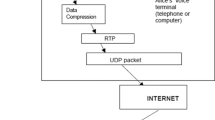Abstract
This article proposes a solution for two issues in current communications. Firstly, that IMS suffers from lack of clients. Secondly, that mobile operators want to give the subscriber a possibility to access their VoIP network and efficiently cover special, densely populated areas like airports. To address these problems, we have developed a novel service architecture, which allows 2G subscribers access to a SIP based VoIP network via WiFi complying security standards. User authentication and authorization is based on the EAP-SIM algorithm. Integrity and confidentiality is provided by IPSec connection established using parameters derived from authentication triplets. Consequently, all security-related issues can be performed exclusively using the Subscriber Identity Module (SIM). We have tested and verified the proposed architecture with a mobile phone and have proven the correctness of our approach. The main drawback that remains is the difficulty of IPSec implementation that can be bypassed by a special application.
Similar content being viewed by others
Explore related subjects
Discover the latest articles, news and stories from top researchers in related subjects.References
IP Multimedia Subsystem (IMS) (March 2010). Stage 2, 3GPP specification 23.228.
3rd Generation Partnership Project: www.3gpp.org.
3rd Generation Partnership Project 2: www.3gpp2.org.
IETF Network Working Group, SIP (June 2002). Session Initiation Protocol, RFC 3261.
Handover requirements between UTRAN and GERAN or other radio systems, 3GPP specification 22.129 (December 2009).
Feasibility study on 3GPP system to Wireless Local Area Network (WLAN) interworking, 3GPP specification 22.934 (December 2009).
IEEE 802.1X, Port based network access control.
IETF Network Working Group (June 2004). Extensible authentication protocol (EAP), RFC 3748.
IETF Network Working Group (July 1994). The point-to-point protocol (PPP), RFC 1661.
IETF Network Working Group (January 2006). Extensible authentication protocol method for global system for mobile communications (GSM) subscriber identity modules (EAP-SIM), RFC 4186.
IETF Network Working Group (January 2006). Extensible authentication protocol method for 3rd generation authentication and key agreement (EAP-AKA), RFC 4187.
Rigney, C., Willens, S., & Rubens, A. (2000). Remote authentication dial in user service RADIUS, RFC 2865.
Calhoun, P., Guttman, E., Zorn, G., & Arkko, J. (2003). Diameter base protocol RFC 3588.
Podhradský, P., Mikóczy, E., Matejka, J., Lábaj, O., & Kotuliak, I. (2007). NGN platform architecture and its adaptation to the evolution trends. In Proceeding of IWSSIP 2007 and EC-SIPMCS 2007 conference, Maribor, Slovenia, June 2007.
Open SIP Server project (March 2010). http://www.opensips.org.
Arkko, J., Torvinen, V., Niemi, A., & Haukka, T. (2003). Security mechanism agreement for the session initiation protocol, RFC 3329.
Access security for IP-based services. 3GPP specification 33.203 (December 2009).
3G security; security architecture. 3GPP specification 33.102 (December 2009).
3GPP 33.220 generic authentication architecture. Generic bootstrapping architecture, 3GPP specification 33.220 release 9 (December 2009).
Author information
Authors and Affiliations
Corresponding author
Rights and permissions
About this article
Cite this article
Vargic, R., Kotuliak, I., Vrábel, A. et al. Provisioning of VoIP services for mobile subscribers using WiFi access network. Telecommun Syst 52, 1705–1711 (2013). https://doi.org/10.1007/s11235-011-9662-6
Published:
Issue Date:
DOI: https://doi.org/10.1007/s11235-011-9662-6




